Being watchmakers: a brief story about the Hausmann watches
A watchmaking tradition that begun in 1794 cannot today give up on making watches with its own brand.
It is indeed the watchmaking work with wich Hausmann & Co. history begun, under the name of Giovanni Romano Ricci, who opened his watchmaker’s shop in the heart of Papal Rome, in Palazzo Piombino. In an age when watchmaking was a craft in the true sense of the word, the master craftsman Romano Ricci won a reputation for skill in the making and repairing of the delicate mechanisms of clocks and watches, and he soon became popular with the upper nobility and clergy.
Precision became a necessity with the progress of 19th century, particularly in view of the strict timetables on which the railways depended in order to function. As a result of the increase in demand, and the high degree of technical innovation, the clock and watchmaker’s craft became an industry, and the workshop a factory. The unique, privately commissioned pieces of the previous century gave way to mass produced models, and the role of watch and clock retailer became more important. Nevertheless, Hausmann & Co. decided to follow producing clocks with its own brand.
Some pieces from this production can still be appreciated in the centre of Rome. The city also bears the Hausmann stamp in the many public clocks gracing the elegant palazzi of the historic centre, ever since the latter was restored in the early 1900s.

Still today interesting objects for collectors, several models of pocket watches were created for the Royal Family, bearing the Savoy arms or the initials of the kings Victor Emmanuel II, Umberto I and Victor Emmanuel III, and also for the nearby Holy See, with engraved the Pope’s coat of arms.

Hausmann & Co., dall’inizio del ‘900, è Fornitore Ufficiale della Santa Sede. Per molti Papi furono prodotti orologi personalizzati con le loro stemma papale.
Qui rappresentati gli orologi per Papa Pio XI e per Papa Benedetto XV. Entrambi in argento, con carica a corona e scappamento ad ancora.
For Milan International Exposition of 1906, an observatory regulator pendulum clock was entirely designed and made by Hausmann & Co. The complicated technical features of the clock earned a Certificate of Honor to Hausmann & Co. at the International Exposition in the section Mail, Telegraph and Metrology, this latter the name of the current watchmaking.

The 1920s saw the production of the first Hausmann wrist-watches: mainly simple timepieces, but some with more elaborate features such as stop-watches (including monopusher chronographs), often ornamented with enamel dials. But most of the demand was for pocket watches and table clock: products by Hausmann & Co. were subject to the same quality control as the prized output of the most important Swiss manufacturers, who were themselves suppliers of components to Hausmann.
During the 1960s and the 1970s the production of watches under the Hausmann brand enjoyed renewed success in partnership with established manufacturers like Ebel and Sarcar and thanks to the expertise of the watchmaker technicians employed in the workshop. This was the period of precious wristwatches, with the cases and sometimes also the bracelets in gold, platinum or silver, also featuring small complications. During all the 1980s, the production of table clock and alarm clock is still copious.
With the advent of electronic clocks, Hausmann & Co. still remains at the top in the installation of time measurement systems field. An internal division of electronic timekeeping for industrial installations was opened (clients included the Italian Navy for warships, Vatican Radio, Italy’s National Research Council and a number of sporting venues).
The watch production with the Hausmann & Co. name on the dial never ended. Still today the loyal Roman customers can find fine watches with a long tradition, a reliable quality and a good price point. The Hausmann & Co. watches are entirely Swiss made and carry exclusively Swiss mechanisms. Classic models, in stainless steel, gold or plated, come together with modern collections for wrists that love bigger and contemporary watch shapes.
Discover the current Hausmann & Co. watches collection!
































